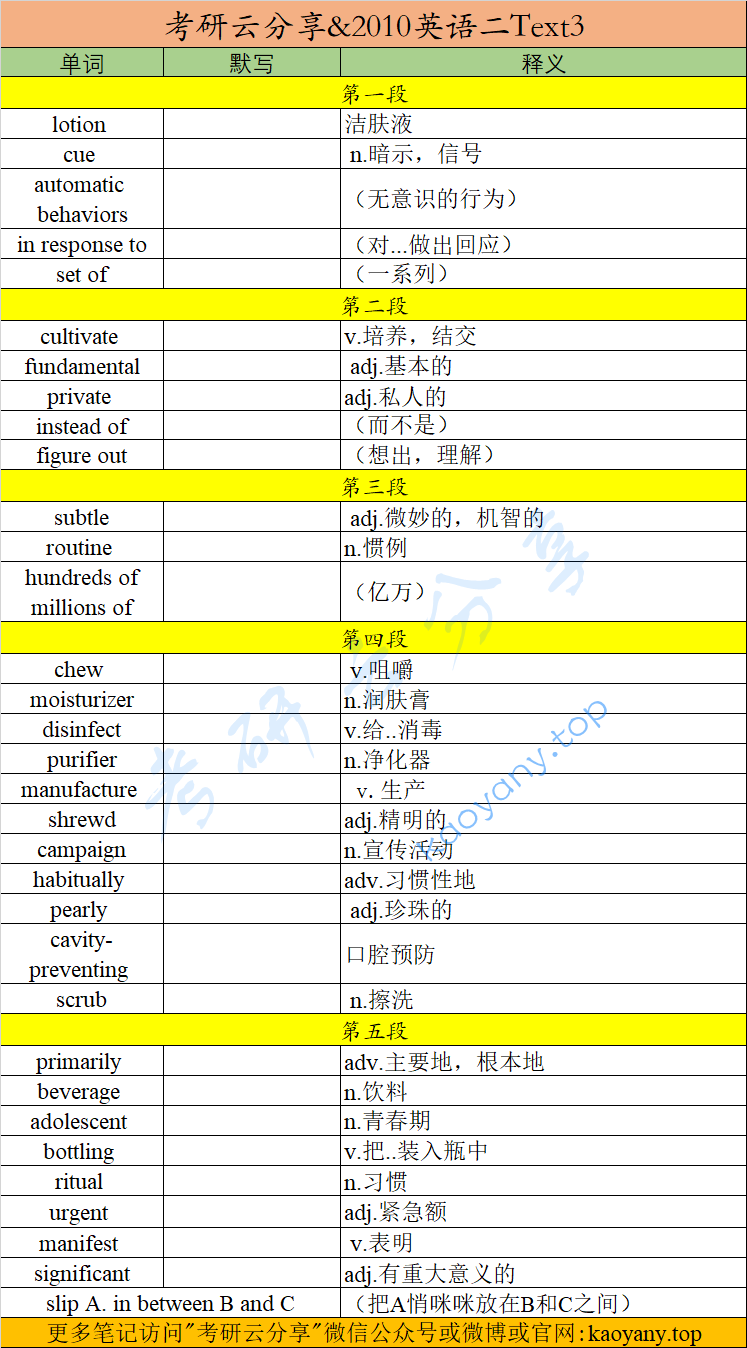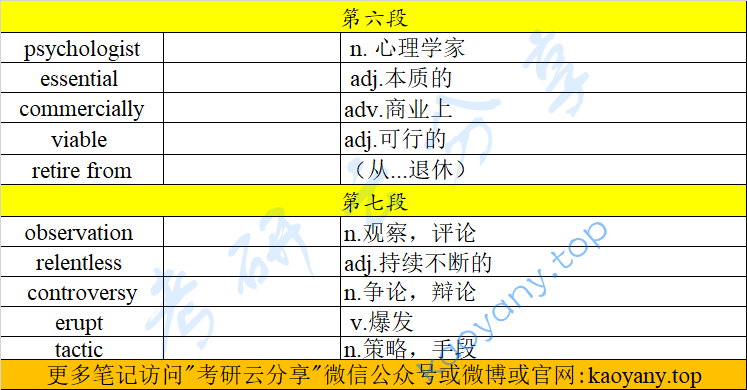第一段
Over the past decade, many companies had perfected the art of creating automatic behaviors — habits — among consumers. These habits have helped companies earn billions of dollars when customers eat snacks, apply lotions and wipe counters almost without thinking, often in response to a carefully designed set of daily cues.
单词&词组搭配
lotion [ˈloʊʃn] 洁肤液
cue // n.暗示,信号
automatic behaviors (无意识的行为)
in response to (对...做出回应)
set of(一系列)
本段翻译
在过去的十年中,许多公司完善了引导消费者无意识行为的艺术。在一系列精心设计的日常暗示影响下,消费者往往几乎不假思索地吃快餐或擦拭柜台,这些行为习惯已经帮助公司赢得了数十亿美元的收益。
第二段
“There are fundamental public health problems, like dirty hands instead ofa soap habit, that remain killers only because we can’t figure out how to change people’s habits,” Dr. Curtis said. “We wanted to learn from private industry how to create new behaviors that happen automatically.”
单词&搭配
cultivate [ˈkʌltɪveɪt] v.培养,结交
fundamental [ˌfʌndəˈmentl] adj.基本的
private [ˈpraɪvət] adj.私人的
instead of(而不是)
figure out(想出,理解)
本段翻译
伦敦卫生与热带医学院卫生中心主任 Curtis 博士说,“有一些基本的公共卫生问题,比如不用肥皂洗手的习惯, 仍然威胁着人们的生命,这是因为我们还想不出办法去改变人们的行为习惯,我们想从私营企业那里学习如何创造 新的无意识习惯行为。”
第三段
The companies that Dr. Curtis turned to — Procter & Gamble, Colgate-Palmolive and Unilever — had invested hundreds of millions of dollars finding the subtle cues in consumers’ lives that corporations could use to introduce new routines.
单词&词组
subtle [ˈsʌtl] adj.微妙的,机智的
routine [ruːˈtiːn] n.惯例
hundreds of millions of(亿万)
本段翻译
Curtis 博士所转向的公司——宝洁、高露洁和联合利华——已经投资数亿美元寻找消费者生活中的微妙线索, 而企业可以利用这些线索来引入新的生活习惯。
第四段
If you look hard enough, you’ll find that many of the products we use every day —chewing gums, skin moisturizers, disinfecting wipes, air fresheners, water purifiers, health snacks, ,teeth whiteners, fabric softeners, vitamins— are results of manufactured habits. A century ago, few people regularly brushed their teeth multiple times a day. Today, because of shrewd advertising and public health campaigns, many Americans habituallygive their pearly whites a cavity-preventingscrub twice a day, often with Colgate, Crest or one of the other brands.
单词&词组
chew [tʃuː] v.咀嚼
moisturizer [ˈmɔɪstʃəraɪzər] n.润肤膏
disinfect [ˌdɪsɪnˈfekt] v.给..消毒
purifier [ˈpjʊrɪfaɪər] n.净化器
manufacture [ˌmænjuˈfæktʃər] v.生产
shrewd [ʃruːd] adj.精明的
campaign [kæmˈpeɪn] n.宣传活动
habitually [həˈbɪtʃuəli] adv.习惯性地
pearly [ˈpɜːrli] adj.珍珠的
cavity-preventing 口腔预防
scrub [skrʌb] n.擦洗
本段翻译
如果仔细观察,你就会发现我们日常使用的很多产品都是“制造”出习惯的结果。如口香糖、润肤霜、消毒湿巾、空气清新剂、净水器、健康快餐、洁牙剂、织物柔软剂和维生素等。一个世纪以前,很少有人每天多次地刷牙。而今天,由于精明的广告宣传以及公共卫生运动,许多美国人每天会习惯性的刷两次他们珍珠白似的牙齿,以预防龋齿,经常使用的产品是高露洁,佳洁士或某种其它品牌。
第五段
A few decades ago, many people didn’t drink water outside of a meal. Then beveragecompanies started bottling the production of far-off springs, and now office workers unthinkingly sip bottled water all day long. Chewing gum, once bought primarily byadolescent boys, is now featured in commercials as a breath freshener and teeth cleanser for use after a meal. Skin moisturizers are advertised as part of morning beautyrituals, slipped in between hair brushing and putting on makeup.
单词&词组
primarily [praɪˈmerəli] adv.主要地,根本地
beverage [ˈbevərɪdʒ] n.饮料
adolescent [ˌædəˈlesnt] n.青春期
bottling [ˈbɑːtlɪŋ] v.把..装入瓶中
ritual [ˈrɪtʃuəl] n.习惯
urgent [ˈɜːrdʒənt] adj.紧急额
manifest [ˈmænɪfest] v.表明
significant [sɪɡˈnɪfɪkənt] adj.有重大意义的
slip A. in between B and C(把A悄咪咪放在B和C之间)
本段翻译
几十年前,许多人不会在餐外时间喝水。后来,饮料公司开始对远处的泉水进行瓶装生产,现在办公室的工作人员会不假思索地整天喝着瓶装水。口香糖在从前主要是小男孩购买,而现在的商业广告宣传它是饭后
清新口气和清洁牙齿的必备品。在广告中,润肤品被认为是每天早上化妆的必备品,成为梳头和上妆之间的一个日常环节。
第六段
“Our products succeed when they become part of daily or weekly patterns,” said Carol Berning, a consumer psychologist who recently retired from Procter & Gamble, the company that sold $76 billion of Tide, Crest and other products last year. “Creating positive habits is a huge part of improving our consumers’ lives, and it’s essential to making new products commercially viable.”
单词&词组
psychologist [saɪˈkɑːlədʒɪst] n. 心理学家
essential [ɪˈsenʃl] adj.本质的
commercially [kəˈmɜrʃəli] adv.商业上
viable [ˈvaɪəbl] adj.可行的
retire from (从...退休)
本段翻译
“当我们的产品成为人们每天或者每周的生活模式时,这些产品就成功了,”最近刚刚从保洁公司退休的消费心理学家Carol Berning说道:“培养良好的生活习惯是改善消费者生活很重要的一部分,同样从商业的角度来讲,它对新产品在市场上的成功至关重要。而去年宝洁公司的汰渍、佳洁士和其他产品的销售额高达760亿美元。创造积极的习惯是改善消费者生活的重要组成部分,同样使新产品商业化的可行性同样重要。
第七段
Through experiments and observation, social scientists like Dr. Berning have learned that there is power in tying certain behaviors to habitual cues through relentless advertising. As this new science of habit has emerged, controversies have erupted when the tacticshave been used to sell questionable beauty creams or unhealthy foods.
单词&词组
observation [ˌɑːbzərˈveɪʃn] n.观察,评论
relentless [rɪˈlentləs] adj.持续不断的
controversy [ˈkɑːntrəvɜːrsi] n.争论,辩论
erupt [ɪˈrʌpt] v.爆发
tactic [ˈtæktɪk] n.策略,手段
本段翻译
Berning博士等社会科学家通过实验和观察发现:无情的广告的确可以将一些特定的行为转化为习惯。但随着这种新的习惯科学的兴起,这一商业策略被商家用来销售一些有问题的化妆品或者不健康的食品,争议也就之出现。
五道题
31. According to Dr. Curtis, habits like hand washing with soap________.
A. should be further cultivated
B. should be changed gradually
C. are deeply rooted in history
D. are basically private concerns
32. Bottled water, chewing gun and skin moisturizers are mentioned in Paragraph 5 so as to____
A. reveal their impact on people’s habits
B. show the urgent need of daily necessities
C. indicate their effect on people’s buying power
D. manifest the significant role of good habits
33. Which of the following does NOT belong to products that help create people’s habits?
A. Tide
B. Crest
C. Colgate
D. Unilever
34. From the text we know that some of consumer’s habits are developed due to _____
A. perfected art of products
B. automatic behavior creation
C. commercial promotions
D. scientific experiments
35. The author’s attitude toward the influence of advertisement on people’s habits is____
A. indifferent
B. negative
C. positive
D. biased
参考答案
AADCB


- 单词 词组搭配
- 本段翻译
- 单词 搭配
- 本段翻译
- 单词 词组
- 本段翻译
- 单词 词组
- 本段翻译
- 单词 词组
- 本段翻译
- 单词 词组
- 本段翻译
- 单词 词组
- 本段翻译
- 五道题
- 参考答案
